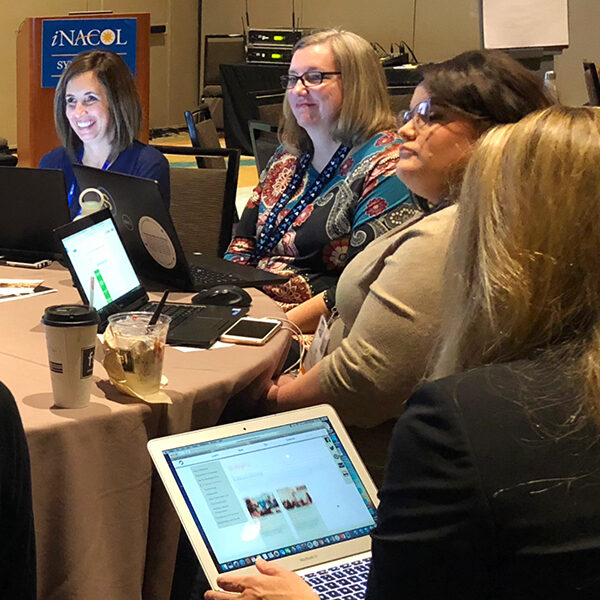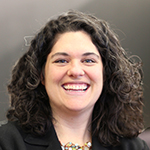
“The hard work we do is a manifestation of love for our students.” – Rachel Moola, iNACOL Teacher of the Year
For a gathering of almost 3000 people, the iNACOL Symposium has the feeling of a family reunion. In all directions, there are people shaking hands, hugging or waving to each other with smiles. Among the crowds of people flowing in and out of conference rooms, colleagues are continually running into each other. People know each other here.
This yearly symposium, hosted by the International Association for K-12 Online Learning (iNACOL) brings together teachers, school and district leaders, policy-makers, direct service providers and ecosystem coordinators to share ideas and best practices for competency-based, blended and online education. Those of us who work in the blended learning space know that the job of personalizing education is not easy. Putting student voice and agency first requires a host of changes to the traditional classroom that redefine not only the role of students and teachers, but also the structures, norms and policies that govern how schools run each day. Pushing to transform our education system to better meet the demands and needs the 21st century can be difficult and lonely work. So, it is perhaps not surprising that people get energized when they are brought together to share their experiences.
As a first-timer to this conference, I was struck both by this comradery and also by the recurring themes that came up repeatedly through the various keynotes, seminars, workshops and networking sessions I attended. Among them, four stood out:
1. Personalizing learning is about strengthening relationships.
Diane Tavenner, Co-Founder and Director of Summit Learning mused in her opening keynote, “Isn’t it funny that we don’t talk more about love in the work we do?” While focusing on people, not just technology, is a familiar trope in the education innovation space, Tavenner’s comment reminded me that this goes well beyond relationships with our students. A state policy-maker I met, for example, worried that district and school leaders don’t always get to know him. “I’ve drunk the Kool-Aid,” he explained, “I’m flexible about what schools should be measuring to show success.” He wondered if he should be doing more to share both his thinking and the pressures he faces since reducing information asymmetry not only eases politics, but it also increases trust and deepens relationships.
There are practical implications for this focus on relationships. Are the district dollars spent on personalizing learning focused mostly on training teachers and coaches on tech platforms or is there a dedicated focus on deepening relationships between teachers and students? Are district leaders taking the time to form bonds with school and teacher leaders to increase trust and reduce information imbalance? Are students engaged not just as “beneficiaries” of innovative practices, but as leaders in its evolution? Are parents and community members being “informed” or asked to help create the best possible learning environments for their children? The message remains: We care for our students by caring for each other.
2. Unfettered freedom does not always create the best conditions for innovation.
Practitioners across sessions talked about the delicate balance between freedom and constraint as co-pilots for innovation. While district leaders spoke about the importance of giving schools enough freedom to personalize in ways that best meets the needs of their students, they also talked about setting constraints as a way to be kind to practitioners making big changes in their work. Aaryn Schmuhl, Assistant Superintendent for Learning and Leadership in Henry County Schools, GA, explained that one of the big lessons his team learned after five years of personalizing learning was to set clear “guard rails” for schools to enable them to take bigger risks. Districts should define the sandbox by setting a clear district vision, enabling leaders to help teachers explore with less confusion about the point of the exercise and what success looks like.
Scott Ellis, Founder and CEO of MasteryTrack (and founding CEO of The Learning Accelerator), takes this idea a step further. In order for innovation to scale, he asserts, we should not be asking teachers across the country to engage in a redundant process of figuring out what mastery looks like for their students. Instead, he says, we can offer teachers more room to focus on knowing, caring for, and challenging their students by centralizing learning objectives. At the very least, district and school leaders should be having explicit conversations about what freedom and authority should be granted individual teachers or schools and what makes better sense to centralize at the district level to eliminate redundancies.
Guard rails are not just about streamlining, though. Perhaps counter-intuitively, they also enable creativity and risk-taking because people are not wondering where their jobs begin and end.
3. In order to fly, you have to be willing to have some crashes.
Unsurprisingly, continuous improvement was a theme that came up again and again among practitioners who are swimming in the uncharted waters of personalizing learning. Harvey Chism, Co-Founder and Executive Director of the South Bronx Community Charter High Schoolremarked in his keynote, “We’ve got to be comfortable with working and reworking our strategies because that is the only lever for change.” This highlights the value of conferences like the iNACOL Symposium where leaders and teachers can share their mistakes and lessons learned with like-minded professionals without fear of blow-back. One school leader noted in a workshop I attended, “When we started this work, we were scouring our communities looking for resources that we could use and everyone kept saying, ‘We can’t share that because it’s not ready yet. It’s not good enough yet. This fear of failure leads to meticulously-crafted case studies that can obscure the real learning that happens from failures.
Schools and districts must be willing to expose themselves to some unpredictability in order to learn what will work best for their students. As Rebecca Midles, head of Student Centered Learning Systems in Mesa County Valley School District 51 explains, “Until you’re in it, it’s hard to explain the importance of tolerating ambiguity as a leader. When we don’t have all the answers, we are more likely to consider many paths.” Middles asked attendees at her session, “Are your systems in place for adult convenience or for student success?” reminding us that it is just as important to iterate on systems as it is on classroom practices. By revealing the vulnerable spots in the system, leaders model the mindset that they are asking teachers to embody. When we don’t have all the answers, we’re more likely to seek multiple pathways.
4. We do not have to demonize the past to imagine new possibilities.
In her powerful workshop on engaging communities in conversations about equity, Dr. Lisa Williams, Executive Director of the Baltimore County Public Schools’ Office of Equity and Cultural Proficiency explained the importance of being aware of people’s attachment to the past. “When you start doing equity work, people often think that you are trying to pick new winners and losers. For decades, our conversation in education has been about win-lose, but equity work must be about win-win.” This frame requires empathy for those who disagree with change you might be leading. It also requires cultivating a genuine curiosity about what we might preserve, rather than rejecting the past as useless or unhelpful. Jennifer Ferrari, Vice President and Chief Schools Officer for Distinctive Schools reminded us that by not demonizing the past, we help people see transformation as an iteration of their work, rather than a rejection of it.
This insight is critical if blended and personalized learning is to become a “new normal” within the traditional public-school system. Decades of teacher practice is not irrelevant to the future of teaching and learning. Innovation does not emerge “out of the box.” Student-driven learning is about leveraging what years of teaching practice has shown – that people learn best when they are valued and seen as the unique human beings they are.

